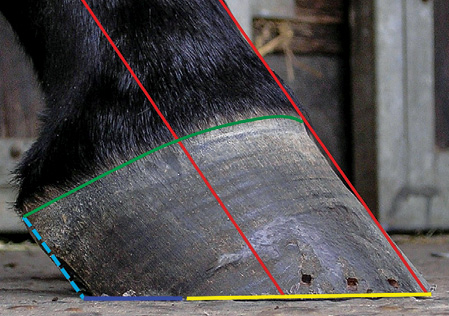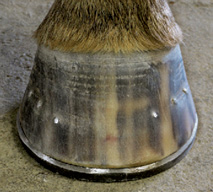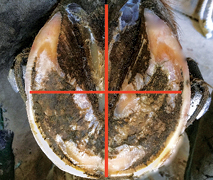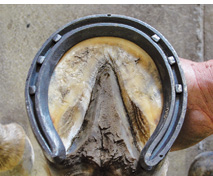When given the opportunity to write about shoeing a normal foot, my first move was to discuss the topic with a well-respected colleague, who quickly asked me “Jeffrey, what is a normal foot?” Naturally, I began to reflect on my daily work, thinking that most of my feet were fairly “normal.” But then I thought about the question more and came to the realization that almost all of my so-called “normal” horses present me with some type of a conformational or structural challenge that I am constantly striving to improve.
A “good” foot is perhaps a better description and certainly desirable, but it too may be elusive if you think of all of the factors that must be considered and met before labeling the foot as “good” or “ideal.”
Evaluation To Find A Sound Horse
Before looking at the foot and making decisions about its footcare needs, farriers must evaluate the horse for soundness. Making judgments only based on surface characteristics, such as foot conformation, the integrity of the hoof capsule and the overall condition of the foot may be misleading if the horse is not observed in motion.
If the horse isn’t sound, you can instantly recognize that you are not working with a good foot.
A thorough farrier will always take time to watch a horse walk, turn in each direction and observe the horse at a trot. Sometimes it is helpful to watch the horse work under saddle prior to working on the horse. During this observation period, the farrier has time to ask any pertinent questions about the horse, its performance since it was last shod, work schedule and any lameness or comfort issues.
Look for subtle discomfort, a head nod or a shortened stride that the owner or trainer may not be aware of or recognize. Any abnormalities that are observed should be brought to the owner or trainer’s attention and discussed prior to any farrier work being performed.
FARRIER TAKEAWAYSDo you thoroughly analyze the horse before you work with its feet? What considerations do you give the foot before trimming it? After selecting the appropriate shoe, what thoughts do you give to the mechanics you’ll add or the shoe fit? |
Evaluation Of The Foot
Prior to starting the farriery, the horse’s feet should be observed from the front, the side and from behind the animal to observe the height of the heels. Any change in foot conformation or hoof capsule distortion should be noted and recorded if possible. Once the farrier begins to work on the foot, he or she is looking at the foot in many different directions and dimensions.
In Figure 1, the foot is labeled with two red lines that represent a good hoof pastern axis and bony alignment of the digit. The yellow line represents solid horn that is mature in nature (10 to 12 months old) and very strong. This area encompasses much of the interface formed by the lamellae between the distal phalanx and the hoof capsule. The solid blue line represents the area of the foot that is relatively immature (2 to 4 months old) and is weak in comparison to the dorsal wall as it is thinner due to the necessity for hoof expansion.

|
|
Figure 1 Photo: Dr. Stephen O’Grady |
The palmar or plantar section of the foot encompasses mostly soft tissue structures (digital cushion, frog, lateral cartilages) and may allow a substantial amount of movement as the foot naturally contracts and expands. The dotted blue line represents the angle of the heel, which ideally would be at the same angle as the toe angle. However, this rarely occurs as the immature horn is worn away during movement.
After shoes are removed, a wear pattern in the heel area on the foot surface of the shoe should be examined. This wear pattern is caused by the movement of the foot expanding and contracting against the shoe and will vary depending on the condition of the heels.
If this movement is wearing a groove or trough into a piece of steel or aluminum, it also will be wearing away the much softer hoof wall at the heels of the hoof capsule. The green line represents a nice flowing coronet that has a gentle slope from the toe to the heel of the hoof capsule with the hair lying nicely in the same direction against the coronet.

|
|
Figure 2 Photo: Jeff Ridley |
Look to see if the horse is standing on the middle of its foot or if the hoof is offset to one side. Examine for the absence of dishes and flares, cracks and/or disparity in size of the growth rings. Looking at the coronet, a straight line drawn from any two points on the coronet should match a line drawn at the ground surface. Although this is a freshly shod foot, Figure 2 reminds of the importance of taking the time to examine your work from various views, including the dorsal view.
Looking at and examining the solar view of the hoof capsule (Figure 3), many points should be considered before labeling it a “good” foot. Using the frog as a guideline, the foot should be evaluated for symmetry in both the medial and lateral direction.
We also want to have approximate distances of foot in front of and behind the widest part of it. Is the frog intact, healthy and prominent? Is the foot concave with uniform hoof wall thickness? Once all of these questions have been asked and answered affirmatively, then you may be justified in saying you have a “good” foot.

|
|
Figure 3 Photo: Jeff Ridley |
Trimming The Foot
Farriers will generally have an individual preference as to how to begin a trim. I start every trim with the frog. I trim each side of the frog, removing any loose or exfoliating horn of the frog that may contribute to trapping debris in the commissures. Minimal vertical depth of the frog is reduced, providing that when it is healthy, it contributes to foot expansion with the digital cushion.
The horn in the body of the sole is left intact and only excess exfoliating sole is removed at the sole/wall junction (white line), which will indicate how much hoof wall should be removed to shorten the toe while maintaining concavity to the bottom of the hoof. The heels should be trimmed to the widest part of the frog or trimmed to include the frog, thus increasing the ground surface of the foot. The end result should have the heels of the hoof capsule and the frog on the same plane.
A symmetrical hoof capsule is finally sculpted as flares are removed from the outer hoof wall and the outer hoof wall is further dressed to achieve a uniformed thickness from heel to heel.

|
|
Figure 4 |
Selecting The Appropriate Shoe
With an endless variety of shoes and other appliances flooding the farrier industry market, shoe selection may be dependent upon the discipline of the horse and further influenced by rider or trainer preferences. Regardless of the shoe or device selected, it must be of adequate size and properly fit to be complementary of the trimmed foot.
Addressing The Mechanics Of The Shoe
If the foot has met all of the criteria to be classified as a “good” foot, there may be minimal need to add mechanics to the shoe that has been selected. Any additional mechanics may be determined by choosing how an arguable point is viewed when looking at the shoe that was removed from the horse. Do you put a new shoe on to prevent undue wear to the toe, or is a new shoe used with the wear pattern ground back into the shoe, as this is how the horse naturally breaks over?
Fitting The Shoe
When applying the selected shoe, it should fit the foot that has been trimmed. Make sure that the foot has been adequately covered and that the commissures or sulci next to the frog are still open and can be readily cleaned. Ideally, the shoe should be secured to the front half of the foot so as not to interfere with the natural expansion and contraction of the palmar/plantar section of the “good” foot. Figure 4 demonstrates how I fit a foot as such.
Putting It All Together
By writing my thoughts down, I better understand the question that my colleague asked, “Jeffrey, what is a normal foot?” I will have to speculate what life would be like if I am ever lucky enough to shoe “good” footed horses that don’t present me with challenges. But what fun would farriery be without constant challenges?







Post a comment
Report Abusive Comment